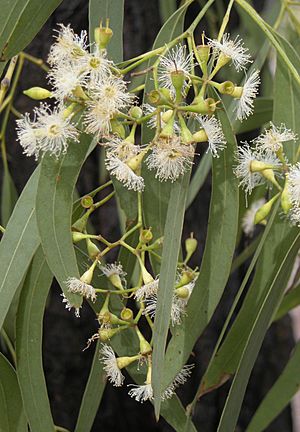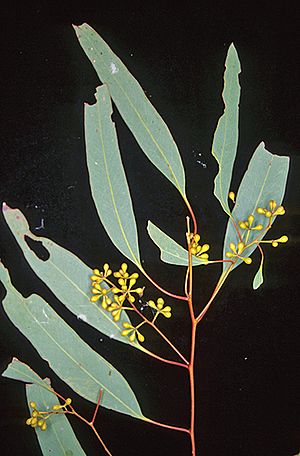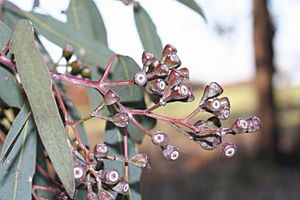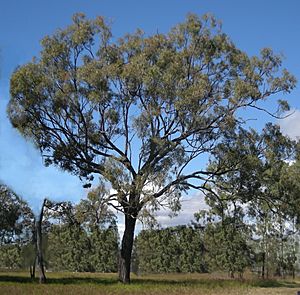Narrow-leaved ironbark facts for kids
Quick facts for kids Narrow-leaved ironbark |
|
|---|---|
 |
|
| Scientific classification | |
| Genus: |
Eucalyptus
|
| Species: |
crebra
|
Eucalyptus crebra, also known as the narrow-leaved ironbark or simply ironbark, is a tree found only in eastern Australia. Indigenous people, like the Dharawal community, call it muggago.
This tree has tough, rough bark that looks like iron, covering its trunk and even small branches. It has long, thin leaves and white flowers that grow in groups. The fruit looks like small cups or barrels.
The narrow-leaved ironbark grows in forests and woodlands from the very north of Queensland down to near Sydney. It is important for making honey because its flowers have a lot of nectar. Its strong wood is also used for building.
Contents
What is a Narrow-leaved Ironbark?
The narrow-leaved ironbark, Eucalyptus crebra, is a type of tree that can grow up to 35 meters (about 115 feet) tall. It has very thick, rough bark that is greyish-black and deeply grooved, giving it the name "ironbark." This bark stays on the tree all the way up to its smallest branches.
Leaves and Flowers
Young plants have long, narrow leaves, about 50-120 mm (2-4.7 inches) long. The adult leaves are also long and thin, about 55-180 mm (2.2-7 inches) long. They are a dull green or greyish color on both sides.
The tree's flower buds grow in groups of seven, nine, or eleven. These groups are usually found at the ends of the branches. The buds are small, about 3-7 mm (0.1-0.3 inches) long, and can be club-shaped or diamond-shaped. When they open, they reveal beautiful white flowers. This tree can flower almost any time of the year.
Fruit and Seeds
After flowering, the tree produces woody fruits called capsules. These capsules are shaped like cups, barrels, or half-spheres, and are about 2-7 mm (0.1-0.3 inches) long. They hold the tree's seeds.
Naming the Ironbark
The scientific name, Eucalyptus crebra, was first officially described in 1859 by Ferdinand von Mueller, a botanist from Victoria, Australia.
The word crebra comes from Latin and means "thick," "close," or "numerous." This name was chosen because this type of eucalyptus tree is very common in the areas where it grows.
Where Ironbarks Grow
The narrow-leaved ironbark grows in sandy soils. You can find it in woodlands and forests from Picton, which is southwest of Sydney, all the way north through New South Wales and Queensland, up to the area near Cairns.
Uses of the Narrow-leaved Ironbark
The timber from the narrow-leaved ironbark is very hard, strong, and dark red. Because of its strength, it has been used for important construction projects, like railway sleepers (the wooden beams that support train tracks).
One famous example of its use is a plank of timber from this tree that was used in Elizabeth Farm, which is Australia's oldest surviving European house.
This tree is also planted as a shade tree or along roadways. It's very useful for honey production because its flowers produce a lot of nectar and pollen. The honey made by bees from these flowers is light in color and has a delicate flavor.
Gallery
See also
 In Spanish: Eucalyptus crebra para niños
In Spanish: Eucalyptus crebra para niños







